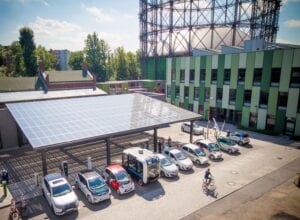Susan Uthayakumar is the former President of the Sustainability Business Division at Schneider Electric. See articles from Steve Wilhite, current President of the Sustainability Business Division, here.
Governments around the world have set ambitious decarbonization goals, showing strong first steps in the path to net-zero emissions and limiting global warming. However, federal and state ambitions alone will only take us so far.
Accelerating decarbonization and meeting these bold goals will require investment and action from the private sector. The challenge for many companies, however, isn’t establishing sustainability ambitions; it’s converting those ambitions into action.
In this blog post, I’ll provide an overview of four steps you can take to propel your company’s sustainability journey. And, I’ll share a link to a detailed guide on the four-step decarbonization process at the end.
Watch our recent webinar on-demand, Restore the Earth: A Response to the Leaders’ Climate Summit
The first step: Know your baseline and your potential
Knowing where you currently are on the decarbonization journey gives you guidance on goal-setting and helps you make faster decisions, including where and how to act.
At Schneider Electric™, we advise our customers to start the decarbonization process by outlining baseline emissions by source. We suggest using a single, digital solution to collect and aggregate the data, such as the EcoStruxure™ Resource Advisor tool. This software keeps all your information in one place and makes it easier to analyze and share data with your stakeholders.
Speaking of stakeholders: keep them in the loop throughout the process. Consulting with them will ensure your decarbonization ambitions align with your organization’s appetite for change.
And finally, model your goals on science-based targets as a best practice. In doing so, your ambitions are more likely to have an evidence-based foundation and maximized return on investment.
The second step: Create and announce targets
Now that you know what goals are possible, it’s time to announce them.
According to our research, making a public announcement encourages companies to set more ambitious goals, meet those goals faster, and boost confidence of success.
Schneider has made our own decarbonization goal announcements, including net-zero CO2 emissions across our entire value chain by 2050. Making formal announcements holds us accountable and has helped us become the world’s most sustainable corporation.
And we’ve helped companies like Clorox, PepsiCo, and Greif, Inc. announce their own science-aligned targets, too.
The bottom line: If you let the world know about your goals, you’ll become more likely to achieve them.
The third step: Deploy decarbonization programs
Of course, aspiring to be net-zero is one thing. The real challenge comes with getting there.
There is no one-size-fits-all approach to decarbonization. A wastewater treatment plant will need to develop a much different plan than a hospital. However, there are many tools at your disposal — the key is determining the right ones for you.
For most organizations, the path to decarbonization involves a unique combination of data management, infrastructure upgrades, innovative technologies, and digital solutions, including:
- Energy management with tracking, performance, and analytics solutions
- Resource optimization with energy performance contracting, enterprise efficiency services, building management systems, connected operational technology, and services
- Low–carbon replacements with renewable energy, alternative fuels, electrification, and Energy as a Service
- Emissions balancing with carbon offset projects
- Supply chain neutrality with sustainable procurement practices, lifecycle assessments, and circular business models
In our experience, decarbonizing results in more than just decreasing emissions — it may also have a positive impact on your company’s efficiency, resiliency, competitive advantage, and bottom line.
The fourth step: Monitor and adjust
Over time, your goals and strategies may change. You may notice that you’re well on your way toward meeting your goals and decide to speed up your timeline. On the other hand, you may need to bring new teams on board, reallocate your financial resources, or add new programs if you’re not on track to meet your goals. And that’s all okay — decarbonization isn’t a linear process.
Also, keep the conversation going, not just with your company stakeholders, but throughout your supply chain. Communicate what’s going well, and what isn’t — so that all parties can work together to meet both federal and corporate decarbonization goals.
If you need help, ask. Partner with other organizations, hire a consultant, reach out to our Climate Change Advisory Services — the support you need is out there.
A call-to-action for corporate decarbonization
A healthy planet isn’t just an option; it’s a necessity. And by taking steps today, organizations can reduce emissions, limit global warming, and meet ambitious climate goals.
I’m proud that Schneider Electric is taking aggressive actions to make a sustainable future a reality, including investing in technologies that make our products and systems more sustainable. But we can also help drive change at your organization, too. In fact, our core offer, EcoStruxure, has helped our customers avoid 120 million tons of carbon emissions. Our teams have decades of experience in energy and sustainability, and we can support you in your decarbonization efforts.




